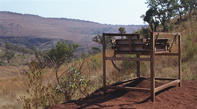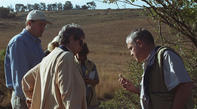The Fossilised Brain
The first major hominid fossil found in Africa was identified by Professor Raymond Dart, way back in 1924. Dart was an Australian who was working in South Africa as a professor of Anatomy at the University of Witwatersrand.

While on a field trip in the Buxton Quarry near the town of Taung in the present-day North-West Province, some of Dart’s students found some interesting fossil specimens that were duly sent to their esteemed Prof.
As Dart himself wrote: “On the very top of the rock heap was what was undoubtedly an endocranial cast or mould of the interior of the skull. Had it been only the fossilised brain cast of any species of ape it would have ranked as a great discovery, for such a thing had never before been reported.
But I knew at a glance that what lay in my hands was no ordinary anthropoidal brain. Here in lime-consolidated sand was the replica of a brain three times as large as that of a baboon and considerably bigger than that of an adult chimpanzee.” Suddenly excited, Dart rummaged through the box and found more fragments of the weird creature’s face.
He quickly realised that this animal showed evidence of walking upright, and the teeth looked strangely human… A few months later, he published a very controversial paper in the scientific journal, Nature. His conclusion was that this skull belonged to a young specimen of a species that fell somewhere between apes and modern humans. He called this species (Australopithecus africanus).
Our Human Origins
All this was considered outrageous by the contemporary scientific community, as it was thought at the time that humans had originated in Asia, and his evidence conflicted with the well-established British fossil called ‘Piltdown Man’ (which was later revealed as a hoax).
Besides, the thought of anything coming out of the dark, backward African continent was simply beyond comprehension and Dart was roundly derided by international colleagues. Nevertheless, a few supporters emerged including Dr. Robert Broom.
Over the years, the accuracy of Dart’s theory was established and today the Taung Child is seen as an important link in our understanding of human origins. Raymond Dart went on to have a long career at Wits and only died in 1988, at the ripe old age of 95.
The Australopithecines

Don’t let the name put you off. Australo means Southern and pithecine means ape. So Australopithecine means Southern ape. This is the name given to a number of early hominid species found both in Eastern and Southern Africa, and it is generally accepted that the Australopithecines are an important link in our evolutionary ladder.
Broadly speaking, there are two types of Australopithecine: the thick ones and the thin ones. The thin ones, also called gracile Australopithecines, are thought to have originated first, and specimens date between 4 million and 2 million years ago. They are characterised by a relatively slight frame and comparatively refined skull (when compared to their ape contemporaries) with quite a large brain capacity for the time. Their pelvis and leg bones also show that they were at least partially bipedal.
There are two main species of gracile Australopithecine: Australopithecus afarensis (found in Eastern Africa) and Australopithecus africanus (found in Southern Africa).